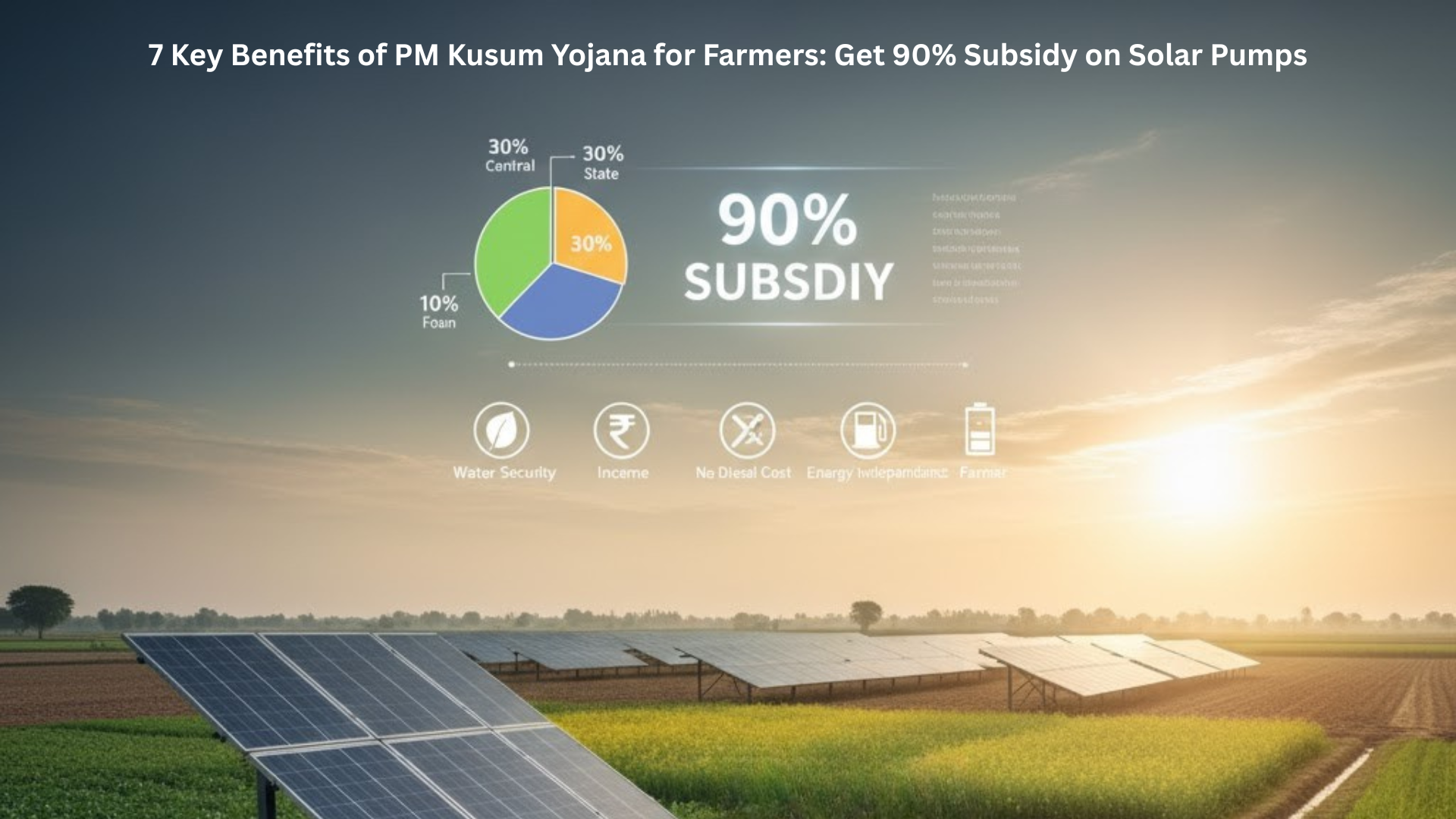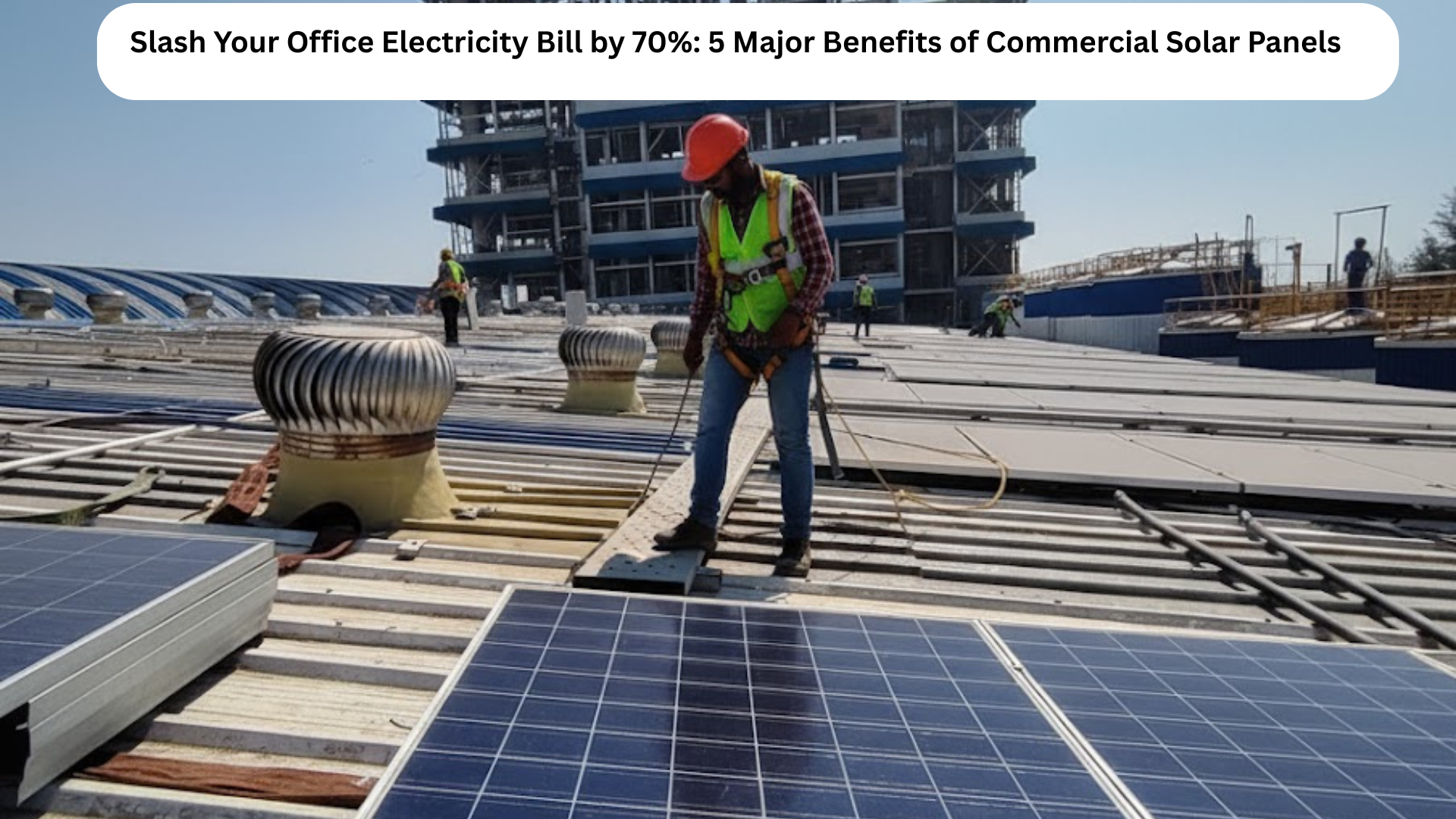In India, farming relies on two critical things: water and power. For decades, farmers have been dependent on expensive diesel and an unreliable grid supply for both. To solve this problem at its very root, the government launched the PM Kusum Yojana. This isn’t just another scheme; it’s a mission to make Indian farmers ‘Urjadata’ (energy producers), offering a chance to get solar pumps with a massive 90% subsidy.
But is the PM Kusum Yojana just about solar pumps, or are its benefits far greater? This scheme is designed to transform Indian farmers from “Annadata” (food producers) into “Urjadata.”
The “90% subsidy” headline grabs your attention, but the true value of this scheme goes much deeper. It’s about securing your water, cutting your single biggest expense, adding a new source of income, and finally, making your farm truly self-reliant.
Let’s dive deep into the 7 key benefits of the PM Kusum Yojana and explore how this one scheme can change your life.
1. Massive Financial Support (The 90% Subsidy Explained)
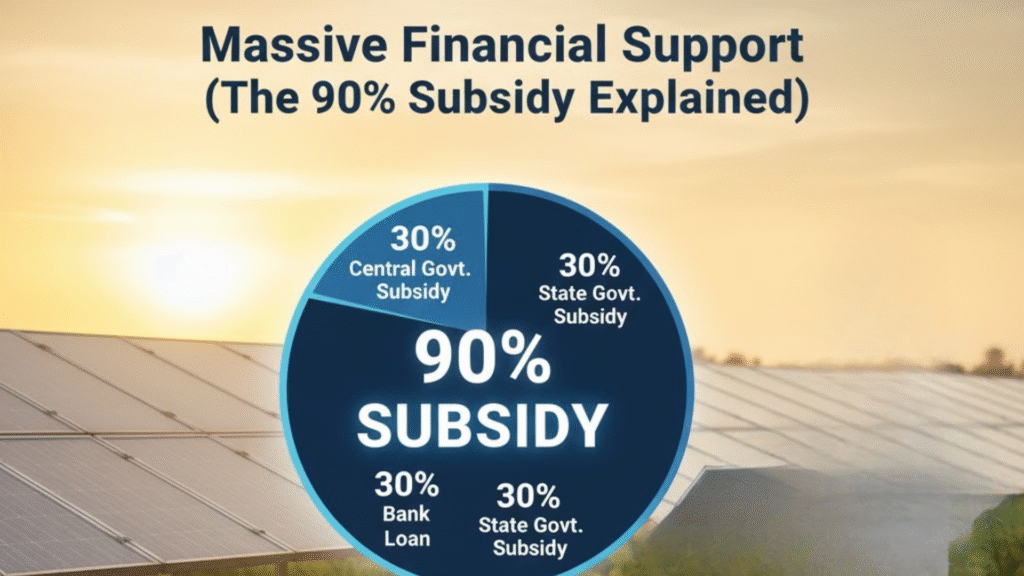
This is the benefit that makes everything else possible. The government understands that a high-quality solar pump system is a significant investment. Under the PM Kusum Yojana, you are not expected to bear this cost alone.
While the exact numbers can vary slightly by state, the financial model is built to be accessible to every farmer:
- 30% Central Government Subsidy: The Government of India provides a 30% subsidy on the benchmark cost of the solar pump.
- 30% State Government Subsidy: Your state government matches this with another 30% subsidy.
- 30% Bank Loan (Optional): You can get a flexible, low-interest loan from a designated bank (like NABARD, etc.) to cover another 30% of the cost.
- 10% Farmer’s Share: This is the magic number. You only need to pay 10% of the total cost from your own pocket.
Let’s look at a real-world example in this detailed table:
PM Kusum Yojana Cost & Savings (Estimated)
| Pump Capacity (HP) | Estimated Total Cost | Govt. Subsidy (60%) | Bank Loan (30%) | Farmer’s Upfront Cost (10%) | Est. Annual Diesel Savings |
| 3 HP | ₹ 2,20,000 | ₹ 1,32,000 | ₹ 66,000 | ₹ 22,000 | ~ ₹ 50,000 – ₹ 60,000 |
| 5 HP | ₹ 3,40,000 | ₹ 2,04,000 | ₹ 1,02,000 | ₹ 34,000 | ~ ₹ 75,000 – ₹ 1,00,000 |
| 7.5 HP | ₹ 4,80,000 | ₹ 2,88,000 | ₹ 1,44,000 | ₹ 48,000 | ~ ₹ 1,10,000 – ₹ 1,40,000 |
(Note: These are estimated costs and savings. The final amount may vary based on your state, vendor, and daily diesel usage.)Think about it: by paying just ₹34,000, you get a 5 HP solar pump system worth ₹3.4 Lakhs. And as the table shows, your annual diesel savings alone can be more than double your initial investment.
2. Goodbye to Diesel Bills and Erratic Power Cuts

If you use a diesel pump, you know the true cost. It’s not just the price of diesel (which only goes up). It’s the cost of maintenance, the messy oil changes, the sudden breakdowns, and the time wasted traveling to get fuel.
A solar pump under the PM Kusum Yojana wipes this problem out completely.
- Zero Fuel Cost: Your fuel is the sun. And it’s free. Every single day.
- No More “Bijli Kab Aayegi?”: You are no longer dependent on the grid. Farmers in many states only get electricity for a few hours at night. A solar pump works during the day, which is the natural and most effective time to irrigate your crops.
- End of Diesel Costs: As seen in the table, a 5 HP pump can save you over ₹75,000 a year. Your new solar pump pays for your 10% investment in just a few months.
A New, Stable Income under the PM Kusum Yojana by Selling Surplus Electricity

This is where the PM Kusum Yojana truly shifts the paradigm. It doesn’t just save you money; it helps you make money.
Under Component A, if you have barren (banjar) or fallow land that isn’t good for farming, you can set up a solar power plant. The DISCOMs will buy this power from you at a pre-determined rate (feed-in tariff) for 25 years. This provides a secure, “drought-proof” income, like a pension, from land that was previously earning you nothing.
Under Component C, you solarise your existing grid-connected pump. Here’s how it works:
- Your solar panels power your pump as needed.
- Let’s say your pump only runs for 100-150 days a year.
- For the remaining 200+ days, your panels are still generating electricity.
- All of that surplus power is fed back into the grid, and the DISCOM pays you for it.
Your pump becomes an asset that earns you money even when it’s not pumping water.
4. Guaranteed Water Security with the PM Kusum Yojana = Higher Value Crops
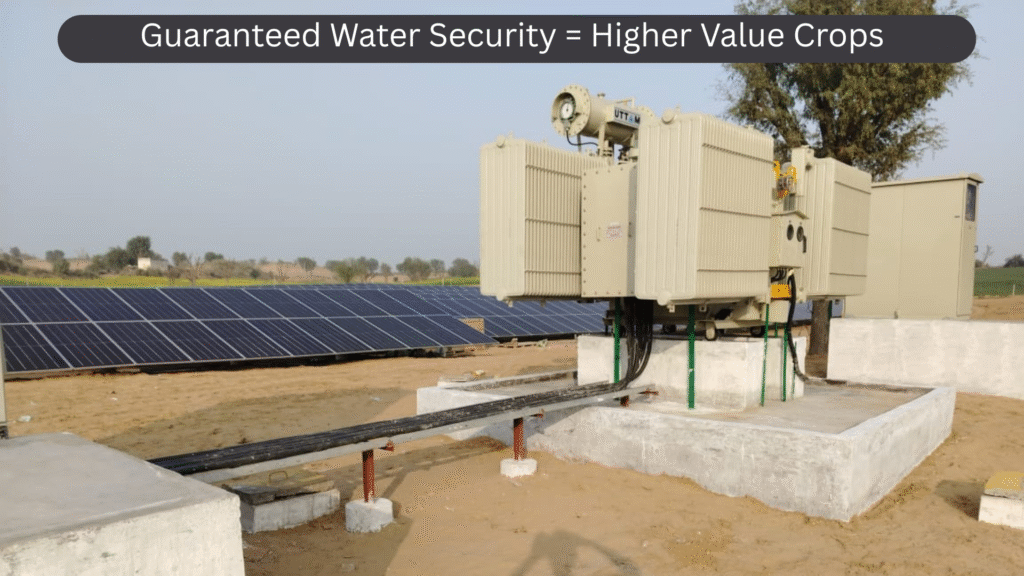
A farmer’s biggest fear is drought. Unreliable rain and an unreliable power supply mean you are always playing defense, often sticking to traditional crops (like wheat or bajra) that can survive harsh conditions but may not fetch the best price.
A solar pump gives you water security. You are in control.
This reliability changes what you can farm. With a guaranteed water supply, you can confidently diversify into high-value cash crops:
- Horticulture (fruits and flowers)
- Vegetables (which require timely irrigation)
- Drip irrigation systems (which work perfectly with solar pumps)
This shift from subsistence farming to high-value commercial farming is only possible with the water security that the PM Kusum Yojana provides.
5. “Fit it, Forget it” – Low Maintenance and Long Life
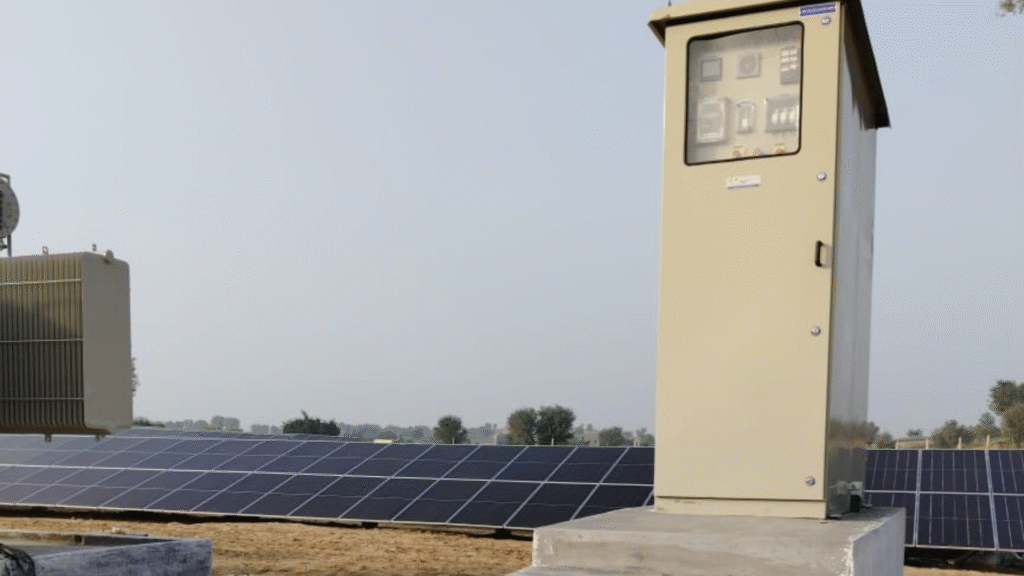
Let’s be honest: diesel pumps are a headache. They have complex engines with hundreds of moving parts that need constant service—filters, engine oil, pistons, and repairs.
A solar pump system is beautifully simple.
- Solar Panels: No moving parts. They just need to be wiped clean of dust every few weeks. They come with a performance warranty of 25 years.
- Pump & Controller: The submersible pump is the only major moving part, designed for high efficiency and durability.
The entire system is built for a long life with minimal human intervention. You invest once (at a 90% subsidy) and get guaranteed, hassle-free performance for decades. It’s the definition of “peace of mind.”
6. Protecting Your Health and the Environment
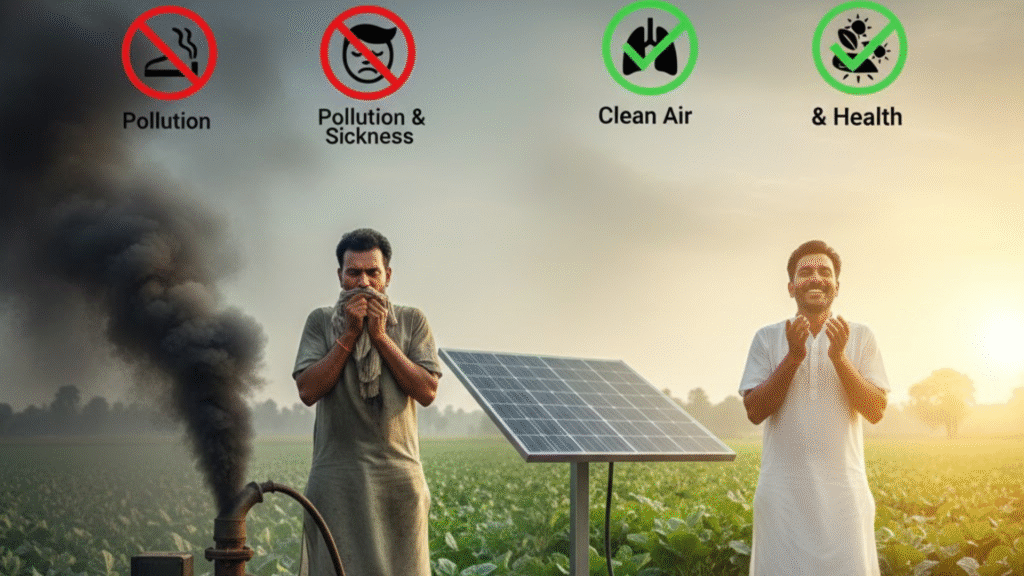
This benefit is often overlooked, but it’s crucial. Diesel pumps are noisy, polluting, and unpleasant to be around. They spew toxic fumes and can leak diesel and oil, contaminating your soil and water.
By switching to solar, you are:
- Improving Your Own Health: No more breathing in diesel exhaust. No more constant, loud engine noise. It creates a cleaner, quieter, and healthier farm environment for you, your family, and your livestock.
- Becoming a Climate Warrior: Every solar pump installed is a direct blow against climate change. You are actively reducing your carbon footprint. The PM Kusum Yojana isn’t just an economic policy; it’s a major environmental one.
7. True Energy Independence (Aatmanirbhar Kisan)

This is the ultimate benefit that ties all the others together. The PM Kusum Yojana is the key to ‘Aatmanirbhar’—self-reliance.
- You are no longer at the mercy of the grid schedule.
- You are no longer at the mercy of global diesel prices.
- You are no longer at the mercy of a mechanic for frequent repairs.
You are in complete control of your farm’s most critical input: energy and water. This independence gives you the power to plan your crop cycles, manage your finances, and build a profitable, sustainable farming future on your own terms.
How to Apply for PM Kusum Yojana (And Avoid Scams)
If these benefits sound good to you, the next step is to apply. But you must be very careful.
⚠️ CRITICAL WARNING: BEWARE OF FAKE WEBSITES
The popularity of this scheme has led to many fake websites that look official. They will ask for a “registration fee” (e.g., ₹500 – ₹5,000) and then steal your money.
REMEMBER: The only official national portal for the scheme is pmkusum.mnre.gov.in. Do not trust any other website. Your state’s official renewable energy portal is also a safe place to apply (e.g., RRECL for Rajasthan, HAREDA for Haryana, etc.).
Here is the general step-by-step process:
- Check Eligibility: You must be an individual farmer, a group of farmers, or a cooperative. You must have agricultural land with a water source.
- Gather Your Documents: You will typically need:
- Aadhaar Card: For identity verification (KYC).
- Land Documents: Khasra/Khatauni or Jamabandi to prove land ownership.
- Bank Account Passbook: A clear copy of the first page (for subsidy transfer).
- Passport-Size Photograph.
- Declaration: A self-declaration that you do not have an existing electric pump connection (this is mainly for Component B).
- Visit the Official Portal: Go to your state’s designated portal or the national PM Kusum portal.
- Register and Apply: Fill out the online application form with your personal details, land details, and the pump capacity you need.
- Application Review: The government department will verify your application and documents.
- Pay Your Share: Once approved, you will be notified to deposit your 10% share of the cost.
- Vendor Selection & Installation: You can then choose from a list of government-approved (empanelled) vendors who will come to your farm and install the entire system.
Frequently Asked Questions (FAQ)
Q: Can a tenant farmer or someone leasing land apply?
A: Yes, in many states, tenant farmers are eligible. However, they usually need to provide a valid lease agreement or a No Objection Certificate (NOC) from the landowner along with the application.
Q: What is the difference between Component B and C?
A: It’s simple:
- Component B is for new, off-grid solar pumps. This is for farmers who primarily use diesel pumps and do not have an electric pump connection.
- Component C is for grid-connected pumps. This is for farmers who already have an electric pump connection and want to solarise it to save on bills and sell extra power.
Q: What is the warranty on the solar pump system?
A: The entire solar pump system (including the pump) comes with a comprehensive 5-year warranty. The solar panels themselves have a performance warranty of 25 years.
Q: Can I get a subsidy for a solar pump if I already have an electric pump?
A: No, you cannot get a subsidy for a new off-grid pump (Component B) if you already have an electric connection. However, you are the perfect candidate for Component C, where you can solarise your existing electric pump.
Q: How long does the application process take?
A: This varies greatly by state and the number of applications. It can take anywhere from a few weeks to a few months. It’s important to apply as soon as your state’s portal opens for applications, as subsidies are often limited.
Q: Do I need a water source (borewell) before applying?
A: Yes. The scheme is for installing a pump. You must already have a water source (borewell, well, pond, etc.) where the pump can be installed.
